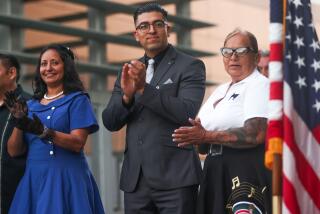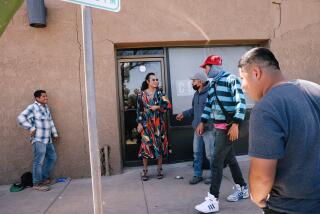Bogus Absentee Ballots Taint Miami’s Mayoral Election
MIAMI — From their wheelchairs, Gloria and Cipriano Alvarez testified that not only had they never cast an absentee ballot for Miami Mayor Xavier Suarez, they had never voted in the United States at all. Furthermore, said the octogenarian Cuban immigrants, they didn’t even live in the city of Miami.
“If I had to vote,” added Cipriano Alvarez, “I would like to vote for Mr. Carollo.”
Nonetheless, the names of the Alvarezes--along with dozens of other ineligible voters, including one dead man--turned up on absentee ballots introduced as evidence in a Miami courtroom this week after former Mayor Joe Carollo filed a lawsuit alleging that widespread fraud forced him into a runoff election last fall with Suarez.
Lawyers for Carollo have asked Judge Thomas S. Wilson Jr., who is hearing the case without a jury, to throw out all 5,000 absentee ballots cast in the Nov. 4 election and declare Carollo the winner. The absentee ballots in the primary heavily favored Suarez, who won the runoff 10 days later.
The civil trial is just the latest sideshow in a political circus that began with months of incendiary campaigning in English and Spanish as Carollo and Suarez, both born in Cuba, slugged it out for votes in this city of 365,000.
After Suarez narrowly won, he roared into office with a series of staff shake-ups and erratic acts that led many observers to question his emotional stability. During his first weeks as mayor, he flew to New York in a futile effort to convince Wall Street that the city’s $68-million debt was fiction, cried in front of reporters, and one night reportedly drove around the city in his bathrobe.
Last month, in a message left on a Miami Herald answering machine, he threatened to pull the city’s legal advertising from the newspaper unless it becomes “a lot nicer to me, my people, my citizens and my city.”
In recent weeks, Suarez, a 48-year-old Harvard-trained lawyer who served as Miami mayor from 1985 to 1993, has kept a less-frenetic pace. But some think his days in office may be numbered. “I would guess that the judge will throw out the election,” said veteran politician Maurice Ferre, who served 12 years as Miami mayor in the 1970s and 1980s and may run again. “Both these guys are so discredited, I would win if I entered, or anybody with any standing could beat them.”
Two men linked to the Suarez campaign have been charged with election fraud, and a state police investigation into bogus absentee ballots continues.
Meanwhile, a county grand jury report issued last week concluded that November elections in both Miami and Miami Beach were tainted. The jury’s report specifically cited efforts “to influence absentee ballot votes, particularly those of elderly voters with little understanding of the absentee voter process.”
On Tuesday several witnesses, most of them as elderly as the Alvarezes and testifying in Spanish through an interpreter, told Wilson that although their names might appear on absentee ballots for Suarez, they had not voted. Handwriting expert Linda Hart testified that as many as 225 of 669 absentee ballots could be forgeries.
At least eight other people, including a Miami police sergeant, have refused to testify in the case.
Wilson is expected to hear several more days of testimony and then make one of several decisions: validate Suarez’s victory; void the election and declare Carollo the winner; order a new election between Suarez and Carollo; or force a new election of all five candidates from the November primary.
Ferre, a wealthy businessman born in Puerto Rico, said he believes a cavalier attitude toward voting regulations reflects “a transposition of the Cuban way, a system that functions through patronage.”
“There is precedent for these things. [Vote fraud] happened with the Irish in Boston in the last century, and in Chicago in my lifetime,” Ferre said. “Now Miami is on the cutting edge of a wonderful experiment called assimilation, and this is just the newest, most visible example of a very American story.”
More to Read
Sign up for Essential California
The most important California stories and recommendations in your inbox every morning.
You may occasionally receive promotional content from the Los Angeles Times.










